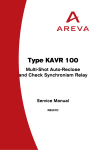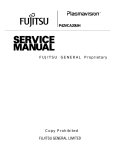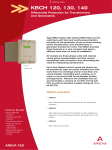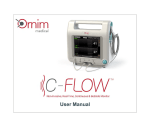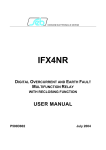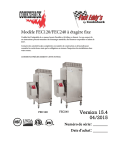Download Multi-shot auto-reclose and check synchronising
Transcript
Type KAVR 100, 130: Multi-shot auto-reclose and check synchronising relay KAVR 100 and 130 are multi-shot auto-reclose relays with integral check synchronising for application to feeders switched by a single circuit breaker. They are intended for use on transmission, sub-transmission and distribution systems As a part of the K range of relays, the KAVR can be integrated into an overall protection and control system by utilising its integral serial communications facility Features Models available • Number of reclosures selectable between 1 and 4 • KAVR 100 3 phase tripping only • Optional single phase reclosure on the first shot • KAVR 130 Single and 3 phase tripping • Integral synchronism check function for auto-reclose and manual circuit breaker closure Application • Selectable undervoltage blocking and differential voltage blocking features • Maintenance alarm and lockout • Independently adjustable timers with wide setting ranges • Flexible operating logic options via software function links • Measurement of line and busbar voltage, system frequency, and phase angle slip frequency • Remote communications via K-Bus • Integral event recorder accessible from remote PC • Comprehensive self-checking and alarms The KAVR 100 provides 1, 2, 3 or 4 shot reclosure of a circuit breaker following a fault on an overhead line. The first shot can be selected to be either high speed or delayed three phase reclosure. The KAVR 130 is specifically designed for transmission and sub-transmission lines where there is a need for singlephase auto-reclosure. In addition to the cycles available on the KAVR 100, it gives the option of high speed singlephase auto-reclose for the first shot. The check synchronising function ensures that the two parts of the system are sufficiently in synchronism before being connected together. This function can also be used with manual switching and is operable even when the auto-reclose function is out of service. Functions KAVR 100/130 466 Auto-reclose The auto-reclose cycle is initiated by the operation of the associated protective relay. Flexible scheme logic is provided to allow the relay to be used for a wide range of applications. The KAVR 130 can be set so that a single phase fault initiates a single phase auto-reclose cycle. If the fault evolves onto all three phases before the relay’s dead time has elapsed, a three phase trip will result. An integral maintenance alarm counts the number of operations of the circuit breaker. It provides an alarm and a subsequent lockout, if the preset thresholds are exceeded. Additional counters indicate the number of relosures which may be attempted before lockout occurs. The KAVR 130 has separate counters for each phase and will also register the total number of single phase and three phase reclosures attempted. Check synchronising The relay checks that the two parts of the system are in synchronism by measuring the angle and the slip frequency between the line voltage and the bus voltage. Auto-reclose is blocked if these values exceed the phase angle and slip frequency settings. Manual closure is blocked if these values exceed the system angle and system slip settings. Selectable undervoltage and differential voltage measurements are available to block closure if the line and bus voltages are not compatible. To allow the circuit breaker to be closed onto an uncharged line; live line/dead bus; dead line/dead bus and dead line/live bus detectors are included. These allow reclosure when the voltage on the line and/or the bus VT is below a preset value. Scheme logic The KAVR uses ladder logic (Figure 1) to implement the scheme. It presents this in the form of contacts, coils, counters and timers that are implemented in the software. In operation, the left side of the ladder is analogous to a positive supply rail, with the right side being negative. The program then acts as an imaginary current flowing left to right, acting upon the components on the rungs of the ladder as appropriate. Changes to the scheme can be made by the user, by opening or closing software function links, to match it to a particular application. Full details of the scheme logic used are included in the relevant logic diagram. (See additional information.) Inputs and outputs KAVR has 8 opto-isolated inputs which may be assigned by the user to any of the available scheme inputs listed in the relevant scheme description. There are 8 programmable outputs, each comprising a relay with 1 normally open contact, which may also be assigned by the user. Ancillary Functions Test features Measurement The relay can display the magnitude of the line and bus voltages, line voltage frequency and slip frequency. The measurements can be selected by the user to be displayed as either primary or secondary quantities. Primary display quantities are based on the VT ratios set in the relay. These quantities can provide a default setting on the LCD situated on the relay frontplate. Event records Fifty events are stored in a non-volatile buffer. Software is available to enable the events to be downloaded to a PC. Any change of state of a control input or output relay, local setting change or operation of a control function, is stored in the relay with a resolution of 1ms. Alarms are also stored as events. A number of features are provided to enable the relay to be thoroughly tested during commissioning, routine maintenance and fault finding operations: • The measurement functions allow the analogue input and its associate wiring to be checked. • The on/off states of the digital inputs and relay outputs can be displayed. Power-on diagnostics and self monitoring Power-on diagnostic tests are carried out by the relay when it is energised. These tests include checks on the timer, microprocessor, memory and the analogue input circuity. Continuous self-monitoring, in the form of watchdog circuity, memory checks and analogue input module tests, is also performed. In the event of a failure, the relay will either lock out or attempt a recovery, depending on the type of failure detected. A dedicated watchdog contact with 1 normally open and 1 normally closed contact is also available. Typical application diagrams (Figures 4 and 5) show the input and output functions assigned as factory default settings. User controls External inputs User controls are provided, via the user interface, to: • switch auto reclosing in and out of service Break • reset the relay from lockout Make • reset ‘Successful AR’ or ‘ CB Failed to close’ indication Sotware relay contact Timer Output Make Figure 1 Example of ladder logic KAVR 100/130 In addition on the KAVR 130 they may be used to: • select single phase, three phase or single/three phase reclosing Function link Sotware relay coil 467 1 Figure 2 56 54 Communications terminal arrangement K-Bus Screened 2 core cable Figure 3 Relay 32 Relay 4 Relay 3 Relay 2 Relay 1 Basic communications system Protocol converter KAVR 100/130 468 KITZ RS232 Desktop p computer PC K-Bus Hardware Description The relay is housed in a Midos size 4 case, suitable for either rack or panel mounting as shown in Figure 6. A highly integrated 16-bit microcontroller uses digital signal processing techniques to analyse power system quantities and implement scheme logic. The micro-controller performs all of the major software functions such as input signal processing, scheme logic, output relay control and handling of the operator interface. The relay has 2 analogue inputs and 8 opto-isolated digital inputs. The internal VTs are used to isolate, step-down and condition the input from the line VTs. Their output signals are then converted into digital data for further processing. The front plate contains a 2 x 16 character, alphanumeric liquid crystal display (LCD) and 4 pushbuttons to provide local access to the relay‘s menu. There are also 3 light emitting diodes (LED) for visual indication of the relay’s status. Standard Midos terminal blocks are located at the rear of the relay providing connections for all input and output circuits such as dc supply, ac voltage and a K-Bus communications port. User Interface Front panel user interface The features of the relay can be accessed through a menu-driven system. The menu is arranged in the form of a table, into each column of which related items (menu cells) are grouped. The user can move around the menu by means of the keys on the frontplate. This can be done with the cover in place, but any change to the settings requires the cover to be removed. Remote access user interface The menu table can also be accessed via the remote communications facility. This allows all of the menu cells in a column to be displayed simultaneously on the screen of a PC. Changes to the menu cell can be made from the PC keyboard. Relay interconnection The relays are interconnected via a shielded, twisted wire pair known as KBus. Up to 32 relays may be connected in parallel across the bus. The K-Bus is connected through a protocol converter known as KITZ, either directly or via a modem, to the RS-232 port of the PC. The KITZ provides signals over the bus which are RS-485 based and transmits at64 kbits/s. The K-Bus connection is shown in Figure 2. Software is available with each KITZ to provide access to the relay to read and change settings. Additional software entitled ‘Protection Access Software & Toolkit’ which provides access to the event recorder, together with other additional functions, is also available. Each relay is directly addressable over the bus to allow communication with the PC. It should be noted that protection tripping and blocking signals are not routed via the K-Bus. Separate conventional cabling is used for these functions. Where appropriate, the isolated 48V dc supply available on each relay is used to energize its optoisolators via external contacts. Communications protocol The communications protocol used with K-Series relays is designated Courier. The Courier language has been developed specifically for the purpose of developing generic PC programs that will, without modification, communicate with any device using the Courier language. In the Courier system, all information resides in the relay. Each time communication is established with the relay, the requested information is loaded to the PC. The protocol includes extensive error checking routines to ensure that the system remains reliable and secure. This system allows up to 32 relays to be accessed through one RS-232 communications port. A pictorial representation of this is shown in Figure 3. Password protection is provided on settings which alter the configuration of the relay, any accidental change to which could seriously affect the ability of the relay to perform its intended function, ie. enable/disable settings, protection function characteristic selection, scheme logic settings and system VT ratios. KAVR 100/130 Password protection 469 KAVR 100/130 470 50 52 54 56 49 51 53 55 10 14 18 20 22 24 26 28 9 13 17 19 21 23 25 27 b a SHORT TERMINALS BREAK BEFORE (c). LONG TERMINAL. PIN TERMINAL (P.C.B. TYPE) (d) c n N C (b) C.T. SHORTING LINKS MAKE BEFORE (b) & (c) DISCONNECT. 48 B A (c) NOTE 1. (a) MODULE TERMINAL BLOCKS VIEWED FROM REAR (WITH INTEGRAL CASE EARTH STRAP) SCN 47 46 44 45 42 43 40 41 38 39 36 37 35 34 8 32 7 33 6 31 4 30 C 5 29 B 3 1 CASE EARTH C B PHASE ROTATION A A c n N C CB AUX SWITCH b B L7 L6 L5 L4 L3 L2 L1 L0 - + 55 53 51 49 47 45 52 50 48 46 20 CASE EARTH CONNECTION RL7 RL6 RL5 RL4 KAVR100 18 19 RL3 RL2 RL1 RL0 WD WD 28 17 26 27 24 25 22 23 21 14 13 NOTE 2. EARTH CONNECTIONS ARE TYPICAL ONLY. LOGIC INPUT COMMON (2) RESET LOCKOUT BLOCK AR NON AR PROTECTION MANUAL CB CLOSE SPRING CHARGED LOGIC INPUT COMMON (1) MAIN PROTECTION INST PROTECTION a A VX A.C./D.C. SUPPLY 8 7 SCN 56 54 1 43 41 39 37 35 33 31 29 44 42 40 38 36 34 32 30 5 3 6 4 - + +48V FIELD VOLTAGE K-BUS COMMUNICATIONS PORT CB FAILED TO CLOSE EXCESS FAULT FREQUENCY MAINTENANCE LOCKOUT MAINTENANCE ALARM BLOCK INST PROTECTION AR LOCKOUT/OUT OF SERVICE CB CLOSE AR IN PROGRESS RELAY FAILED RELAY HEALTHY Figure 4 Typical application diagram KAVR100 50 52 54 56 49 51 53 55 10 14 18 20 22 24 26 28 9 13 17 19 21 23 25 27 b a c n N C LONG TERMINAL. PIN TERMINAL (P.C.B. TYPE) (d) KAVR 100/130 SHORT TERMINALS BREAK BEFORE (c). (c) C.T. SHORTING LINKS MAKE BEFORE (b) & (c) DISCONNECT. 48 B A (b) NOTE 1. (a) MODULE TERMINAL BLOCKS VIEWED FROM REAR (WITH INTEGRAL CASE EARTH STRAP) SCN 47 46 44 45 42 43 40 41 38 39 36 37 35 34 8 32 7 33 6 31 4 30 C 5 29 B 3 1 CASE EARTH C B PHASE ROTATION A A c n N C CB AUX SWITCH b B L7 MANUAL CB CLOSE - + 55 53 51 49 47 45 52 50 48 46 20 56 54 1 43 41 39 37 35 33 31 29 44 42 40 38 36 34 32 30 5 3 6 4 8 7 SCN CASE EARTH CONNECTION RL7 RL6 RL5 RL4 KAVR130 18 19 RL3 RL2 RL1 RL0 WD WD 28 17 26 27 24 25 22 23 21 14 13 NOTE 2. EARTH CONNECTIONS ARE TYPICAL ONLY. LOGIC INPUT COMMON (2) L6 L5 L4 L3 L2 L1 L0 RESET LOCKOUT "BLOCK AR" FROM PROT. CB SPRING CHARGED/ AIR/GAS PRESSURE AR INIT. PROT C PH LOGIC INPUT COMMON (1) AR INIT. PROT B PH AR INIT. PROT A PH a A VX A.C./D.C. SUPPLY - + +48V FIELD VOLTAGE K-BUS COMMUNICATIONS PORT CB TRIP ENABLE 1 PH TRIPPING INHIBIT P.S.B. INHIBIT D.E.F./CB POLE DISCR. SYNC CHECK OK FOR MAN. CL AR LOCKOUT/OUT OF SERVICE CB CLOSE AR IN PROGRESS RELAY FAILED RELAY HEALTHY Figure 5 Typical application diagram KAVR130 471 Technical Data Phase angle settings Voltage settings • Check synchronism 5° to 90° • Undervoltage 22V to 132V • Differential voltage 0.5V to 22V System synchronism 5° to 90° • Line/bus dead voltage 5V to line/bus live voltage • Line/bus live voltage Line/bus dead voltage to 132V Relay ratings • Inputs: • • • AC voltage Slip frequency settings Vn (nominal) 63.5/110V Operating range 0 to 327V • Maximum withstand 375V • Auxiliary voltage Vx 24/125V or 48/250V ac or dc • • • Check synchronism 0.001Hz to 2.0Hz • System synchronism 0.001Hz to 2.0Hz • Frequency 50/60Hz Frequency range 46Hz to 65Hz AC voltage 0.02VA at 110V phase/neutral • Auxiliary voltage The burden on the auxiliary supply depends upon the number of output relays and control inputs energised. DC supply KAVR 100/130 472 AC supply 0.01s to 300s Dead time 2 1.00s to 300s Dead time 3 1.00s to 9999s Dead time 4 1.00s to 9999s Reclaim time 1.00s to 600s System synchronism delay 0.1s to 99s Burdens • KAVR100 Dead time 1 Check synchronism delay 0.1s to 99s Field voltage 48V dc (current limit: 60mA) No. of output relays No. of control inputs Typical burden 0 0 2.5 – 6.0W 2 2 4.0 – 8.0W 8 8 5.5 – 12W 0 0 6.0 – 12VA 2 2 6.0 – 14VA 8 8 13 – 23VA Voltage transformers 1:1 to 9999:1 • Opto-isolated inputs Eight – energised from 48V field voltage • Nominal rating • Off voltage • On voltage≥35V 50V dc ≤12V Contacts • Output relays Eight single make • Contact ratings Check synchronism window 0.01s to 600s Make and carry for 0.2s 30A Auto-reclose inhibit after manual close 0.01s to 300s Break 50W resistive 25W inductive (L/R = 0.04s at 300V max) Close pulse • Transformer ratios Digital inputs Time settings Output: • : Carry continuously 5A 0.01s to 10s Durability KAVR130 Dead time 1 0.01s to 300s Dead time 2 1.00s to 9999s Dead time 3 1.00s to 9999s Dead time 4 1.00s to 9999s • Loaded contact 10,000 operations minimum. • Unloaded contact 1000,000 operations minimum Single phase dead time 1 0.01s to 5s Communications port (K-Bus) Reclaim time • Language Courier • Transmission mode Synchronous • Signal levels RS485 • Message format HDLC • Data rate 64 kbits/s • Connection • Cable type Screened 1.00s to 600s Check synchronism delay 0.10s to 99s System synchronism delay 0.10s to 99s Check synchronism window 0.01s to 9999s Auto-reclose inhibit after manual close 0.01s to 600s Close pulse Multidrop (32 units) twisted pair of wires 0.01s to 5s • Cable length 1000m (maximum) • Connector Screw terminals (M4) • Isolation 2kV rms for 1 minute • • Dielectric withstand IEC 60255-5:1977 2kV rms for 1 minute between all case terminals (except terminal 1) connected together and the case earth/terminal 1. • • Electrical environment • High frequency disturbance IEC 60255-22-1:1988 Class III 2.5kV peak between independent circuits. 2.5kV peak between independent circuits and case earth. Operating AC ripple on DC supply IEC 60255-11: 1979 Humidity IEC 60068-2-3:1969 56 days at 93% RH and 40°C • Enclosure protection IEC 60529:1989 IP50 (dust protected) • Vibration IEC 60255-21-1:1988 Response Class 1 Endurance Class 1 • Shock and Bump IEC 60255-21:1988-2:1988 Shock Response Class 1 Shock Withstand Class 1 Bump Class 1 • Seismic IEC255-21-3 1993 Generic Standards were used to establish conformity. Product Safety 7 72/23/EEC Compliance with the European Commission Low Voltage Directive. EN61010-1: 1993/A2:1995 EN60950:1992/A3: 1995 Compliance is demonstrated by reference to generic safety standards. Class 1 Case The relay is housed in a size 4 Midos case as shown in Figure 6. Fast transient disturbance IEC 60255-22-4:1992 Class III 52 4 holes Ø 4.4 97 2kV, 5kHz applied directly to all inputs. IEC 60801-4: 1988 Level 4 23.5 All dimensions in mm. 168 4kV, 2.5kHz applied directly to auxiliary voltage, watchdog and trip capacitor. 159 Push button projection 10 max. 4kV, 2.5kHz, via capacitor clamp to all inputs. • • Mechanical environment EN 50081-2:1994 EN 50082-2:1995 1.0kV peak across terminals of the same circuit. • IEC 60068-2-2:1974 Dry heat EMC Compliance Compliance with the EuropeanCommission Directive on EMC is claimed via the technical Construction File route. • –25°C to +55°C IEC 60068-2-1:1990 Cold 89/336/EEC High voltage impulse IEC 60255-5: 1977 Three positive and three negative impulses of 5kV peak, 1.2/50µs, 0.5J between all terminals and all terminals (except terminal 1) and case earth/terminal 1. Temperature IEC 60255-6:1988 Storage and transit –25°C to+70°C The unit will withstand 12% ac ripple on the dc supply. 1kV rms for 1 minute across the open contacts of the watchdog relay. • • The unit will withstand a 10ms interruption in the auxiliary supply, under normal operating conditions, without de-energising. 2kV rms for 1 minute between terminals of independent circuits,including contact circuits. 1.5kV rms for 1 minute across open contacts of output relays 0 to 8. Atmospheric environment DC supply interruption IEC 60255-11:1979 99 Panel cut-out: Flush mounting fixing details. Electrostatic discharge IEC 60255-22-2:1989 Class III 32 212 25 min. 8kV – discharge in air with cover in place. IEC 60801-2:1991 Level 2 157 max. 177 4kV – point contact discharge with cover removed. 103 Figure 6 Reset Flush mounting. KAVR 100/130 High voltage withstand 11 Case outlines size 4 473 Additional Information • KAVR/KAVS/KVTR service manual R8505 • KAVR100 scheme description R6523 • KAVR130 scheme description R6539 • KAVR100 logic diagram 08 KAVR100 01 (11 sheets) • KAVR130 logic diagram 08 KAVR130 01 (12 sheets) • KAVR130 service manual R8523 Glossary • Courier • A communications language developed to provide generic control, monitoring, data extraction and setting changes on remote devices (primarily on protective relays) within the substation environment. K-Bus The 64 kbps twisted pair cable used to connect Courier compatible devices and transfer Courier data. • KITZ The interface unit which converts between K-Bus and IEC60870-5 FT1.2 format data, which is used to transfer Courier data over modems and RS232 connections. Information required with order Relay type KAVR Models available: Three phase tripping 1 0 0 Single and three phase tripping 1 3 0 Configuration: Standard 0 1 Case size: Size 4 MiDOS flush mounting L 1 Auxiliary voltage: 24/125V 2 48/250V 5 Transformer ratings: Vn = 57.7 / 120V In = 0A KAVR 100/130 474 J Language: English Issue: E









